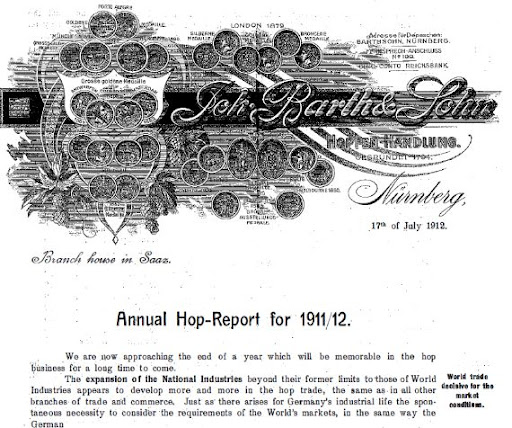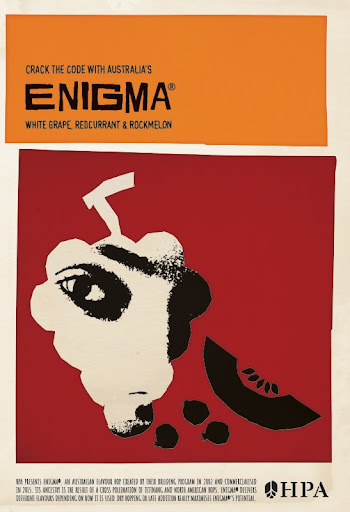Stan Hieronymus Hop Queries - July 2022 July 2022
Each month respected beer writer Stan Hieronymus produces Hop Queries, a must-read summary of what is happening in the hop world, and has kindly offered to let us publish it for Australian industry readers. If you would like to subscribe directly, you can here.
July 2022
- Watching the weather
- Barth Haas report
- New variety alert
- Hops . . . sans alcohol
- Crosby Hops recipe book
- Suggested reading
Welcome to Vol. 6, No. 3. BarthHaas published its annual report this week, as it has for more than 100 years. Even though information related to the hops industry (acreage, production, etc.) is better disseminated than it was a few years ago, this remains essential reading. What’s different this year is more data is presented in visual form; most definitely in contrast to 1911-12 (pictured below).

About the weather
How will record heat in England and on parts of the European continent affect the 2022 hop crop? It was not a death sentence, but there were concerns even before the hottest weather arrived.
In Czechia, growth and development of hops was very good until June 19, when unusually hot weather settled in. “On some hop gardens the stretching growth completely stopped. For this reason part of the hops will not reach the height of the trellis,” according to the Bohemia Hops monthly report. As we learned last year, when Czech growers harvested the best crop in 25 years after forecasts called for a below average crop, hop plants can rally in the last month before harvest.
In the Halltertau region of Germany, farmer Florian Seitz, who sells much of his crop to American craft breweries, reports “hops are not looking good.” Two major hail storms hammered parts of the Hallertau, one of them destroying about 500 hectares (more than 1,200 acres). Hallertau growers harvested about 17,000 hectares last year. Recent rain has cooled the region and Seitz expresses hope that a quality crop may still be harvested.
In England, Charles Faram managing director Paul Corbett describes the crop as “looking thirsty.” Early growth was good and “there certainly isn’t widespread panic at this stage,” he wrote via email last week. “It’s much cooler today and there is a 50 percent chance of rain tonight and tomorrow so we remain hopeful.”
Hop market ‘oversupplied’

A press release introducing the BarthHaas report points out that above-average 2021 crop yields have led to further oversupply of the market. The impact of this is most apparent in contract markets. “Contract durations are becoming shorter due to uncertain expectations. Customers enquiring about contract restructuring and delayed call-offs of hop products already ordered are further indications of lower demand and continuing inventory build-up,” BarthHaas managing director Peter Hintermeier says in the press release.
“The hop industry worldwide is struggling with an unprecedented increase in production costs at all stages of the value chain,” Hintermeier says. “Production cost increases and overproduction are a dangerous combination presenting the hop industry with huge challenges.”
Of course, an excess of alpha does not translate to lower hop prices across the board. For instance, there was spot demand for Cascade, Willamette, Mt. Hood, Crystal and Liberty last year—none of them hops you think about when somebody says “high demand” —because the supply was already tight and yields were a bit light. As reported last month, growers have reacted to shifting demand by adjusting acreage.
Also from the report:
- I pointed this out last year, but the differences still have me shaking my head. There are 655 farms in Poland growing hops, three and a half acres on average. There are 61 growers in the Pacific Northwest (many who farm in multiple locations), harvesting more than 880 acres on average.
- China produces more beer than any other country in the world, but “there are no reliable statistics on (hop) acreage and production volume in China.” The report estimates that growers in China harvested 6,285 metric tons in 2021, which would rank behind only the United States, Germany and the Czech Republic in production. Almost 90% of that is used for bittering.
- In contrast, farmers in the United States devote 78% of acres to aroma varieties. Other countries: Poland 51%, German 53%, Czechia 98%, Slovenia 98%.
- Growers in the Pacific Northwest harvested more metric tons of Citra alone than farmers in New Zealand, Australia, France, Spain, England, South Africa, Austria, Belgium, Argentina and Japan produced in total.
Meet YQH-1320
How hard is to name a hop these days? Yakima Quality Hops is taking orders for YQH-1320 (the numbers refer to the ages of founder Tim Sattler’s children) while they try to find a name that captures the character of the hop, promotes sales and doesn’t step on any trademarks toes.
YQH-1320 is a hop Sattler found growing wild in northern Idaho in 2016. He’s had the genetics checked and she doesn’t match any existing varieties. It would be interesting to know more about her heritage—does she have any uniquely European genes? —and perhaps someday we will. Sattler had HopTechnic (click, and scroll down) analyze 1320’s oil and thiol composition, providing pretty good clues about her brewing potential. If she were a baseball player her slash line (alpha/beta/total oil/thiols) would read 9.3/6.8/1.3/4MMP present.
After YQH harvested a half-acre in 2021, they took samples to the Craft Brewers Conference in September and again in May, to get a feel for demand. They’ve made a pretty big bet on 1320’s future, with 64 acres under wire in 2022.
Looking beyond beer
No surprise, those in the hop industry would like to find uses for hops outside of beer. That’s why a hop dealer checking in with breweries around the Denver area also paid a visit to Hoplark (see Hop Queries, Vol. 6, No. 1). That’s why BarthHaas will be showcasing four non-alcoholic beverages at Drinktec in September.
They are a carbonated soft drink flavored with Spectrum and botanicals; a tonic water with hops instead of quinine; a kombucha with hops; and a non-alcoholic beer flavored with Spectrum, Incognito, mate and ginseng.
Galaxy, the video game
Those of you who have been hanging out here a while may recall that when NZ Hops introduced Nectaron they sent out an invitation to assemble a Nectaron-infused playlist (which is why I am listening to The Staple Singers’ version of “Masters of War” as I type). Not to be outdone, Hop Products Australia has created videos to show off new looks for each of their propriety varieties.

I’m partial to the one for Ella, which reaches back to an era well before the variety was born, but you may prefer Galaxy’s arcade vibe. My favorite of the new logos is the one for Enigma (shown directly above).
Crosby Hops Recipe Book
Crosby Hops has assembled a free-to-download recipe book featuring 18 beers served in their hospitality lounge at the 2022 Craft Brewers Conference. I recommend the Cold IPA from Creature Comforts.
Suggested reading
A look at how hop growers choose the varieties they plant
“A nice decade of market stability from 2012 to now—where growers could invest in facilities, staff, infrastructure—[now] appears to be moving toward the boom-and-bust cycle,” says Diane Gooding, VP of operations at Gooding Farms in Parma, Idaho. The pressure to plant accurately—that is, matching what brewers will need—is intensifying.
Quite often the results of academic studies, like the ongoing research into hop terroir at Oregon State University I’ve written about here, sit behind paywalls. This paper is free to read. Here’s a taste: “Overall, the beers containing Mosaic hops from Oregon had a slightly more vegetal, sweaty, and resinous aroma, whereas the beers containing Mosaic hops from Washington seemed to exhibit a more fruity, floral, and herbal aroma.”
This story could have had more about his relationship with hops, so I will add bit. I met him in the 1990s when he was at S.S. Steiner, where he helped build a hop pelletizing facility that set a new standard for the industry. Before he left Steiner to take charge of brewing at Deschutes he suggested developing T-35 powder, hops in a concentrated form that became a secret ingredient in some craft brewery beers long before Yakima Chief Hops introduced Cryo Hops in 2017. And he remains a fan of the concentrated products that have followed. “I’m a believer. The thing I like about concentrated hops is the lack of astringency that comes from T-90 pellets. Even with the improved T-90 pellet, it still adds too much astringency for my taste buds.”
Are hops the secret ingredient in Maker’s Mark?
The headline kind of gives away the story.
Has a cartel taken over the hop world?
Should I be offended by this statement? “One thing the hop industry lacks is unbiased information regarding current events, industry trends and their likely implications.” That’s a rhetorical question. Don’t feel a need to reply. Doug MacKinnon, who was never afraid to ruffle feathers before 47Hops went bankrupt, has started a Substack newsletter. In his first post, he promises it will be thought-provoking. As the headline on the latest suggests, he’s not holding back.
Topics to explore?
Thank you for subscribing. If you have queries you’d like to see addressed drop me a line at stan@appellationbeer.com

